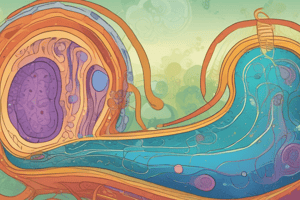Podcast
Questions and Answers
What happens to a peroxisome after it accumulates more proteins and expands?
What happens to a peroxisome after it accumulates more proteins and expands?
- It fuses with another organelle.
- It breaks down into smaller molecules.
- It undergoes fission. (correct)
- It undergoes apoptosis.
Which condition is primarily caused by mutations in peroxin genes?
Which condition is primarily caused by mutations in peroxin genes?
- Zellweger syndrome (correct)
- Cystic fibrosis
- Mitochondrial myopathy
- Hunter syndrome
What can accumulate in tissues due to impaired peroxisome function?
What can accumulate in tissues due to impaired peroxisome function?
- Very long-chain fatty acids and branched chain fatty acids (correct)
- Short-chain fatty acids
- Glucose
- Ketone bodies
Which of the following is associated with Zellweger syndrome?
Which of the following is associated with Zellweger syndrome?
What type of genetic mutation primarily causes Zellweger syndrome?
What type of genetic mutation primarily causes Zellweger syndrome?
Which factor is NOT associated with the peroxin genes implicated in Zellweger syndrome?
Which factor is NOT associated with the peroxin genes implicated in Zellweger syndrome?
What role do peroxins play in the cell?
What role do peroxins play in the cell?
What is an effect of accumulating long-chain fatty acids in cells?
What is an effect of accumulating long-chain fatty acids in cells?
What is a common facial characteristic associated with peroxisomal disorders?
What is a common facial characteristic associated with peroxisomal disorders?
Which is a typical symptom experienced by infants with peroxisomal disorders?
Which is a typical symptom experienced by infants with peroxisomal disorders?
What long-term developmental issues are common in patients with peroxisomal disorders?
What long-term developmental issues are common in patients with peroxisomal disorders?
What effect does Zellweger syndrome have on the central nervous system's myelin?
What effect does Zellweger syndrome have on the central nervous system's myelin?
How do patients with peroxisomal disorders typically engage in feeding?
How do patients with peroxisomal disorders typically engage in feeding?
Which animal model was used to investigate direct insulin signaling in the liver?
Which animal model was used to investigate direct insulin signaling in the liver?
What procedure was performed on the mice to assess glucose tolerance?
What procedure was performed on the mice to assess glucose tolerance?
What is indicated by a reduction in serum insulin concentrations in the experiment?
What is indicated by a reduction in serum insulin concentrations in the experiment?
What is the primary function of enzymes found in peroxisomes?
What is the primary function of enzymes found in peroxisomes?
How do peroxisomes differ from lysosomes regarding their origin?
How do peroxisomes differ from lysosomes regarding their origin?
What essential process occurs in liver cell peroxisomes?
What essential process occurs in liver cell peroxisomes?
What is the fate of hydrogen peroxide in peroxisomes?
What is the fate of hydrogen peroxide in peroxisomes?
Which of the following accurately describes the genetic makeup of peroxisomes?
Which of the following accurately describes the genetic makeup of peroxisomes?
What role do peroxisomal targeting signals play in the function of peroxisomes?
What role do peroxisomal targeting signals play in the function of peroxisomes?
How does the role of peroxisomes in membrane formation contrast with their detoxifying functions?
How does the role of peroxisomes in membrane formation contrast with their detoxifying functions?
Which of the following substances do peroxisomes primarily convert to water?
Which of the following substances do peroxisomes primarily convert to water?
What technique was used to study the mice's hepatic glucose production?
What technique was used to study the mice's hepatic glucose production?
What was the mean blood glucose concentration maintained during the insulin clamp procedure?
What was the mean blood glucose concentration maintained during the insulin clamp procedure?
What is the function of phosphorylase activated by glucagon signaling?
What is the function of phosphorylase activated by glucagon signaling?
Which of the following enzymes was not mentioned in relation to the metabolic profiling of the liver?
Which of the following enzymes was not mentioned in relation to the metabolic profiling of the liver?
What type of animal model was used in the described experiments?
What type of animal model was used in the described experiments?
What role does cAMP play in glucagon signaling?
What role does cAMP play in glucagon signaling?
What does lactate provide for gluconeogenesis?
What does lactate provide for gluconeogenesis?
What is the purpose of the Northern blotting technique in the context of the experiments?
What is the purpose of the Northern blotting technique in the context of the experiments?
Flashcards
Peroxisome Function
Peroxisome Function
Peroxisomes break down toxic substances, especially hydrogen peroxide, a byproduct of cellular processes.
Hydrogen Peroxide Breakdown
Hydrogen Peroxide Breakdown
Peroxisomes contain enzymes that convert hydrogen peroxide into water, making it harmless.
Liver Peroxisome Role
Liver Peroxisome Role
Liver peroxisomes detoxify harmful compounds like alcohol by oxidation.
Peroxisome Lipid Production
Peroxisome Lipid Production
Signup and view all the flashcards
Peroxisome vs. Lysosome Origin
Peroxisome vs. Lysosome Origin
Signup and view all the flashcards
Peroxisome DNA Lack
Peroxisome DNA Lack
Signup and view all the flashcards
Peroxisome Protein Importation
Peroxisome Protein Importation
Signup and view all the flashcards
Peroxisomal Targeting Signals
Peroxisomal Targeting Signals
Signup and view all the flashcards
Peroxisome Fission
Peroxisome Fission
Signup and view all the flashcards
Zellweger Syndrome
Zellweger Syndrome
Signup and view all the flashcards
Peroxins
Peroxins
Signup and view all the flashcards
VLCFA and BCFA
VLCFA and BCFA
Signup and view all the flashcards
Autosomal Recessive Disorder
Autosomal Recessive Disorder
Signup and view all the flashcards
Plasmalogens
Plasmalogens
Signup and view all the flashcards
Impaired Peroxisome Function
Impaired Peroxisome Function
Signup and view all the flashcards
PEX Genes
PEX Genes
Signup and view all the flashcards
Peroxisomal disorders
Peroxisomal disorders
Signup and view all the flashcards
Facial abnormalities
Facial abnormalities
Signup and view all the flashcards
Hypotonia
Hypotonia
Signup and view all the flashcards
Developmental delay
Developmental delay
Signup and view all the flashcards
Glucose tolerance test
Glucose tolerance test
Signup and view all the flashcards
Insulin signaling
Insulin signaling
Signup and view all the flashcards
Experimental hypothesis
Experimental hypothesis
Signup and view all the flashcards
Blood glucose measurement
Blood glucose measurement
Signup and view all the flashcards
Insulin tolerance test
Insulin tolerance test
Signup and view all the flashcards
Euglycemic, hyperinsulinemic clamp technique
Euglycemic, hyperinsulinemic clamp technique
Signup and view all the flashcards
Hepatic glucose production
Hepatic glucose production
Signup and view all the flashcards
Northern blotting
Northern blotting
Signup and view all the flashcards
Phosphoenolpyruvate carboxykinase (PEPCK)
Phosphoenolpyruvate carboxykinase (PEPCK)
Signup and view all the flashcards
Glucose-6-phosphatase (G6Pase)
Glucose-6-phosphatase (G6Pase)
Signup and view all the flashcards
Liver pyruvate kinase (L-PK)
Liver pyruvate kinase (L-PK)
Signup and view all the flashcards
Glucokinase (GK)
Glucokinase (GK)
Signup and view all the flashcards
Study Notes
Peroxisomes
- Peroxisomes are organelles that contain enzymes to rid cells of toxic substances, specifically hydrogen peroxide.
- Hydrogen peroxide is a byproduct of cellular metabolism.
- They convert hydrogen peroxide into water, making the toxic substance safe.
- Some peroxisomes, like those in liver cells, detoxify alcohol and other harmful substances by transferring hydrogen from toxins to oxygen molecules (oxidation).
- Others are crucial for phospholipid production, which is vital for membrane formation.
Peroxisome Structure and Function
- Peroxisomes have a single membrane.
- The core contains enzymes involved in specific metabolic pathways.
- They self-replicate, unlike mitochondria.
- Peroxisomes obtain needed proteins from the surrounding cytosol. This process of obtaining proteins from the cytosol isn't fully understood but requires specific targeting signals found in amino acid sequences.
- These signals attach to receptor proteins in the cytosol and docking proteins in the peroxisome membrane.
Peroxisomal Disorders
- Zellweger syndrome is an autosomal recessive disorder caused by mutations in genes encoding peroxins, proteins essential for normal peroxisome assembly.
- Mutations in related PEX genes often cause deficiencies in peroxisome function.
- Affected individuals often have characteristic facial abnormalities (e.g., high forehead, frontal bossing, small face, low-set ears, and slanted eyes).
- They commonly present with hypotonia (floppy muscles), developmental delays, and mental retardation.
- Peroxisomal disorders can lead to an accumulation of very long-chain fatty acids (VLCFAs) and branched-chain fatty acids (BCFAs) within tissues and cells, potentially impairing multiple organ systems.
- Reduced levels of plasmalogens (ether-phospholipids) in brain and lung tissue are often seen.
Oral Glucose Tolerance Test (OGTT)
- The OGTT measures blood glucose levels after consuming glucose. The test gauges how well the body regulates blood glucose after glucose consumption.
- Blood glucose levels are measured at various time points after glucose ingestion.
- Corresponding insulin levels are measured at the same time points to see the immediate response of the body's endocrine system.
- A graph of blood glucose versus time is plotted, and normal/abnormal results can be noted.
Glucose Homeostasis
- Glucose homeostasis is regulated primarily through the actions of insulin and glucagon.
- Insulin, released from the pancreas’ beta cells, reduces blood glucose levels. It aids glucose uptake into cells and encourages glycogen storage.
- Glucagon, released from alpha cells in the pancreas, increases circulating glucose. It stimulates glycogen breakdown in the liver, enhancing gluconeogenesis.
Type 1 Diabetes
- Type 1 diabetes results from an autoimmune attack of insulin producing beta cells in the pancreas. Beta cells no longer produce sufficient insulin.
- In type 1 diabetes, the body cannot appropriately regulate blood sugar or utilize glucose for energy.
Insulin Secretion
- The release of insulin into the blood is a complex process in response to elevated blood glucose levels.
- The glucose uptake into beta cells leads to metabolic pathways. The result leads to membrane depolarization, which prompts the opening of calcium channels.
- The influx of calcium ions triggers the release of insulin granules into the blood stream.
GLUT4 Translocation
- Insulin promotes glucose uptake by activating the translocation of glucose transporters (e.g., GLUT4) to the cell membrane.
- Muscle cells and adipocytes require insulin for glucose uptake, meaning the proper function and release of insulin is necessary for these cells to respond to glucose.
- The absence of insulin prevents the recruitment of GLUT4 to the membrane impeding the ability of these cells to use glucose for energy.
Glucagon Regulation
- Glucagon, produced by alpha cells in the pancreas, is fundamental in regulating the homeostasis of glucose levels.
- Glucagon is triggered by hypoglycemia (low blood glucose) and acts on the liver in response to lower than normal blood glucose levels.
- Glucagon increases blood glucose through stimulating glycogenolysis (glycogen breakdown) and gluconeogenesis (formation of glucose).
- Increased glucagon results in increased glucose in the blood.
Glucagon Signaling in the Liver
- Glucagon signaling in the liver mainly occurs through a G-protein coupled receptor (GPCR) pathway which utilizes protein kinases (e.g., PKA).
- Glucagon binds to the liver receptor causing a cascade of intracellular events.
- The subsequent actions decrease glycogen stores and increase glycogen production (gluconeogenesis), increasing glucose in the blood.
- Pyruvate and lactate are crucial substrates for gluconeogenesis, offering vital building blocks for sugar production.
Studying That Suits You
Use AI to generate personalized quizzes and flashcards to suit your learning preferences.





